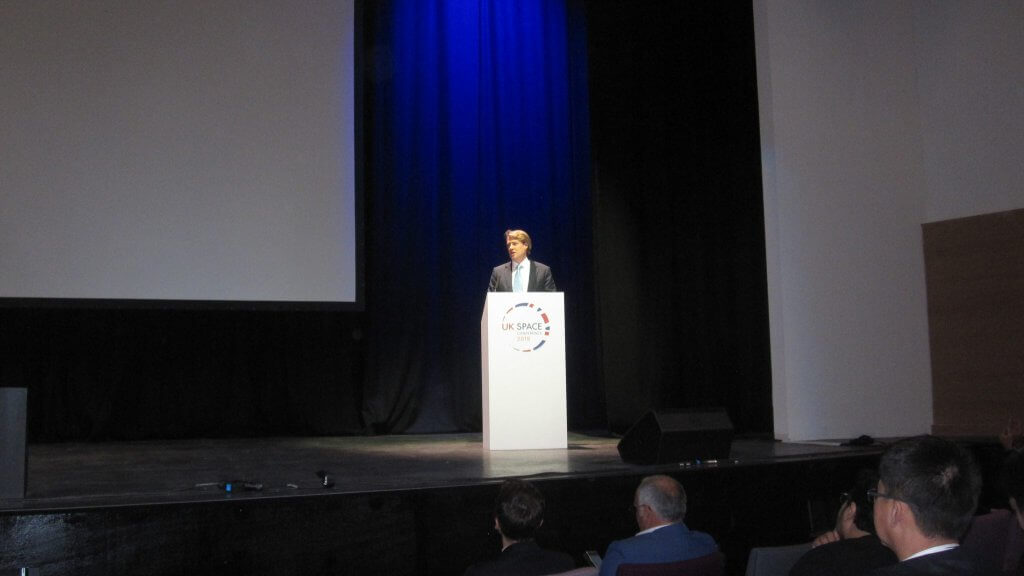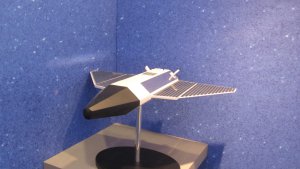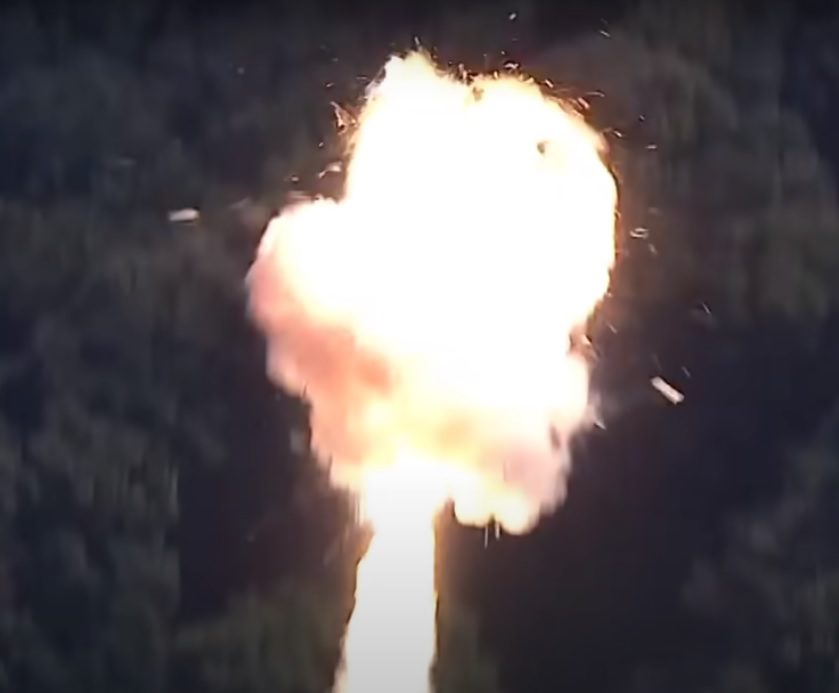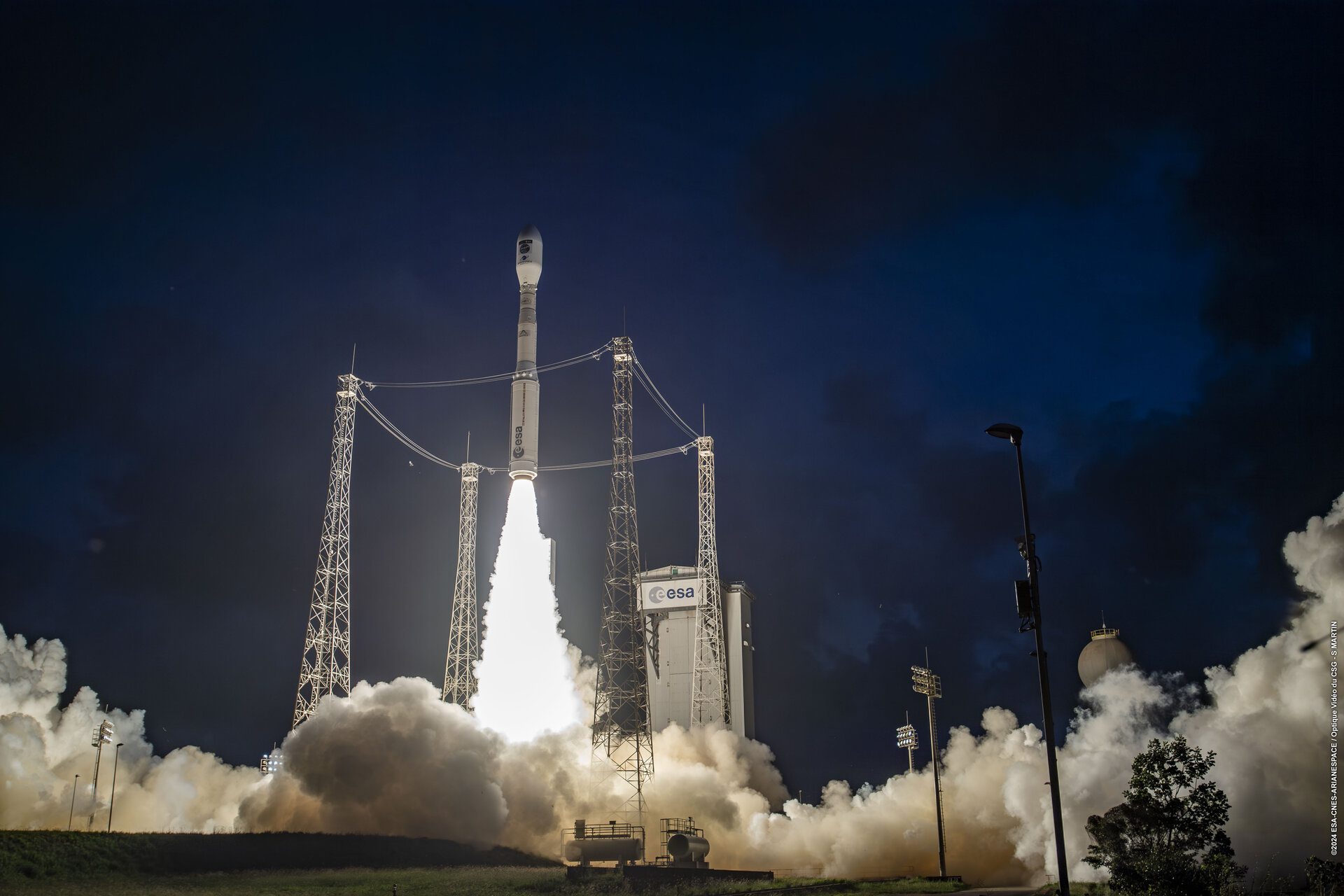While General Election “purdah” curbed policy announcements and political appearances at the 2017 UK Space Conference in Manchester, hopes were high that this year’s conference in Newport, South Wales, would be better. And it was, but only in terms of the attendance of government ministers. Like London buses they came along in a three – all hoping to benefit from the sexy subject of space. However, apart from some good speeches and panel discussions, in truth, little of major consequence was announced.
Heading up the ministers was the Rt Hon Chris Skidmore, who has returned to the role of space minister – or rather Minister for Universities, Science, Research and Innovation (strangely, despite its importance, there is no mention of space in his admittedly overloaded title). Skidmore reaffirmed the UK’s commitment to and support for the European Space Agency (ESA). “If ESA did not exist, somebody would have to invent it,” he said, adding that the UK would increase its contribution to ESA.
Probably the most significant announcement was that of UK Prime Minister Boris Johnson, which was off-site at the UN General Assembly. This was about the government’s £20m investment in research to improve systems at the Met Office Space Weather Operations Centre that help predict severe space weather events.
Skidmore highlighted the political importance of space as a “cross government critical national infrastructure”. Apart from protecting the nation from the impact of natural phenomena, such as space weather, UK defence minister Anne-Marie Trevelyan warned against the potential activities in space of hostile states and non-state actors, including interceptor missile attacks and cyber warfare. The Ministry of Defence is awarding £1.5 million to companies to come up with ways to defend its in-orbit assets including, bizarrely, via the use of origami. The UK is part of a space defence alliance with the USA called Olympic Defender. Surrey Satellite Technology Ltd (SSTL) is building a military data relay satellite constellation for the RAF called Team Artemis, working with the American company, Raytheon.
During the opening plenary, Andy Green, outgoing head of the industry body UK Space, possibly to the chagrin of the pro-Brexit government ministers present, lamented that the UK’s market share in the world space industry had fallen since the leave vote in the 2016 referendum. Graham Turnock, CEO of the UK Space Agency, a government department, said that even after Brexit, the UK could take part in some European Union (EU) space programmes if it was in its interest to do so.
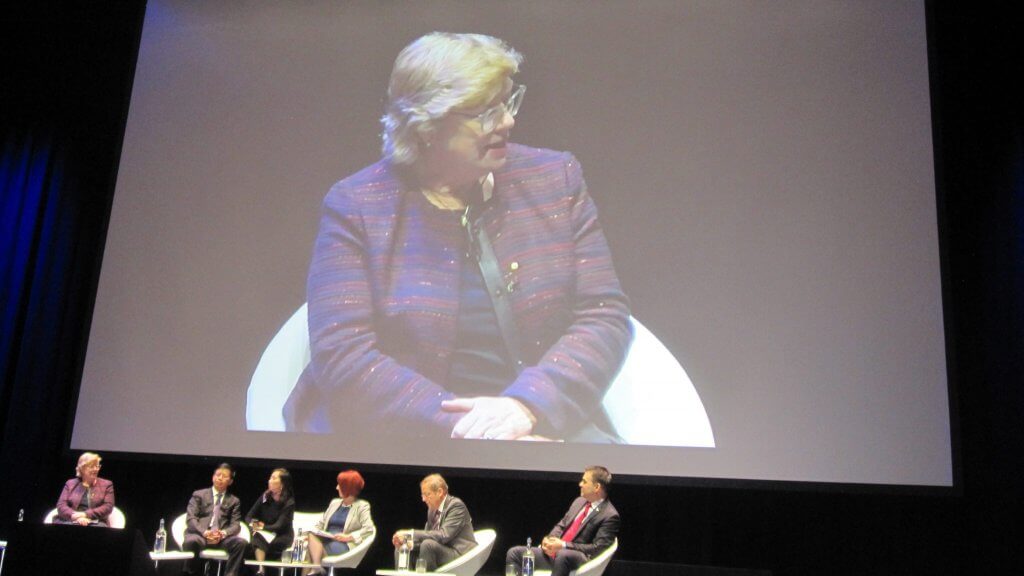
Megan Clarke. Head of the Australian Space Agency, makes her point at the UK Space Conference 2019. Courtesy: Seradata/David Todd
An agreement was signed at the conference between the UK Space Agency and the Australian Space Agency to set up a “Space Bridge” between them to unlock investment and share best practice across a common framework. Megan Clark, head of the Australian agency, was part of the “mini-IAC” heads of agencies plenary, which also included Turnock and ESA Director General Jan Woerner. Clark reported that Australia had formally joined NASA’s Project Artemis to return humans to the Moon. Setting up a space agency in Australia had been a good decision as it provided a “door” to other nations’ governments and space industries. She emphasised that cooperation between agencies would continue even if her dream of there being a world space agency was a long way off.
Money, of course, was a key subject. Turnock explained that the agency had to pick and choose what to fund but there was a conundrum to be solved in trying to pick winners. “Do we pick the best projects or the best sub-sectors?” He reaffirmed the agency’s commitment to encourage new launch capabilities – if not to invest directly in a launch vehicle. This would include capping launch liabilities as well as, probably, providing some spacecraft to be launched as payloads to stimulate demand. Later in the conference it was revealed that should a launch failure occur it would be the Air Accident Investigation Branch (AAIB) that would investigate.
Wu Yanhua, vice-administrator of the Chinese National Space Agency (CNSA), paid tribute to the achievements of the Chang’e 4 mission, which had survived 10 nights on the lunar far side. He also said that all commercial spaceflights were insured by local Chinese insurance companies, sometimes with international insurance backing. Clark warned however that insurance can sometimes stifle risk and entrepreneurial spirit.
On the subject of how space technology could be more environmentally friendly, Woerner suggested that in addition to offering the shortest or the fastest route, SatNav systems could also offer car drivers the “greenest route”. Best quote of the plenary came from ESA director general Jan Woerner, who noted the pressure he came under to choose certain special projects to fund: “I am director general, not director special.”
He described how certain operations, such as communications, are increasingly being taken over by commercial firms but that space agencies would still have to cover others such as planetary exploration and planetary defence, for example. He made it clear that some competition was essential if low-cost spaceflight was to be achieved.
It was also revealed that £1.3 million would be divided between three consortia preparing horizontal operations at Space Ports. The three selected were Space Port Cornwall at Newquay, Snowdonia Aerospace at Llanbedr, Gwynedd, and the Campbeltown airbase at Machrihanish in Argyll and Bute. This former RAF aerodrome has the longest runway in the UK and is supported by a consortium including Reaction Engines Limited. While a relatively small sum (compared with the amount going to the Sutherland vertical space port), the news is significant as horizontal launching via carrier aircraft is likely to start ahead of any UK vertical satellite launch operation. Virgin Orbit’s LauncherOne is likely to be a major user and is nearly ready to begin its initial launch operations in USA – even if it will need to cut its costs to survive in the longer term against cheaper vertically launched rockets.
Graham Stuart, minister for investment at the Department for International Trade, spoke of a new “Space Park” industrial hub in Leicester, due to open in 2020 which has already attracted the Airbus Earth Observation team. It is hoped that the Space Park will encourage manufacturers of low-cost satellite hardware to relocate there.
The UK Government and the UK Space Agency wants the UK to take 10 per cent of the World’s space market by 2035, and in some parts of the industry it is already there. Via firms like SSTL and AAC Clyde, it already produces 40 per cent of the world’s small satellites. Likewise, the UK remains very strong in building plantary science payloads with several on ESA’s Exomars rover.
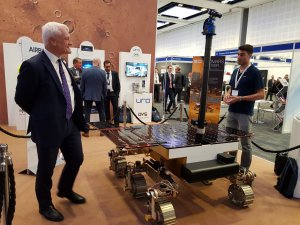
UK Department for International Trade’s (DIT) Minister for Investment, Graham Stuart, checks out the ExoMars rover. Courtesy: DIT
Industry announcements included SSTL, the University of Oxford and the Surrey Space Centre being awarded National Space Technology Programme funding to develop a novel self-aligning deployable space telescope, designed for sub-1 m ground sample imaging in a small launch volume spacecraft. SSTL and Leonardo have been awarded funding from the UK’s Centre for Earth Observation Instrumentation to develop a new MWIR imager for small spacecraft.
UK Space Industry wants to encourage female contribution
The space industry remains male dominated, hence the UK Space Agency’s decision to join the Women in Aerospace Europe (WIA-E) body as a corporate member to encourage a greater role for women in the industry. The WIA-E is led by Liz Seward, an accomplished space engineer and executive at Airbus Defence and Space.
While the UK space industry normally balks at positive gender discrimination policies, it is happy to encourage career opportunities for women which it hopes will lead to more women in space leadership positions. There has been some success already – half of the UK Space Agency’s executive board members are women, as well as 46% of all staff.
In education, in which the agency has had a key role, girls are now flocking to the so-called STEM subjects (science, technology, engineering and mathematics). These smart kids realise that these subjects will give them a better chance of an interesting and rewarding future career. On that educational note, UK ESA astronaut Tim Peake is doing his bit with a new initiative to reach one million children with engagement activities in the coming year. The UK agency is seeking a candidate for the latest ESA astronaut recruitment programme. Those with an education up to a Master’s degree level, ideally in a STEM subject, will have an advantage, as will those with a sub-1.88 m stature and sub-37 year age.
The Technical Sessions
Among all the talks about general space policy and how to export more, there were a few jewels. It was especially interesting to hear that, with £1 billion funding, the UK is now No.3 in terms of investment in Quantum applications after the USA and China. Quantum technology can be used for computing and optics/interferometry techniques. Mamah Maheshwarappa, of the Rutherford Appleton Laboratory, described the new QKD 8U Cubesat-sized spacecraft which will test out quantum encryption techniques in 2022.
One session was devoted to industry trends including how satellite services revenues are falling and how very low Earth orbits have great benefits, not least in having an assured de-orbit capability. As well as the known advantages, such as better communications and higher resolution for optical systems, other benefits include a lower radiation environment, better pointing accuracy and low space debris, as well as being better for spectrum reuse due to the low horizon. The trick, however, is to stay in these orbits given the atmospheric drag. Continuous use of an electric thrust engine is normally required (e.g. the GOCE mission’s T5 which burned for 36,000 hours). Andrew Bacon, of Thales Alenia Space, said that Skimsat bus design studies showed that 200-260 km is the optimal altitude in terms of cost/benefit. Bacon admitted that should the engine fail, even temporarily, the engineers would only have 14 days or so to fix it before the spacecraft hit the “altitude of no return”.
Another panel considered new in-orbit propulsion designs, and the subject of what defines a “green thruster”. Propellants such as hydrazine are known to be poisonous and carcinogenic, and thus require careful handling. However, Adam Watts, of the engine maker Nammo, suggested that other industries used far more hydrazine than the space industry, which accounts for only 2% of world hydrazine supplies. Research continues to find a replacement propellant. Similarly, there is an urgent need to find new sources of Xenon gas for electric thrusters. While they have become de rigueur for modern satellites, ESA propulsion expert Mark Ford did not think that electric thrusters would usurp chemical propulsion. Both would have a role. All the panelists accepted Ford’s suggestion that electrolysed water was showing potential as the ultimate “green” propellant.
While Reaction Engines Limited (REL) is mainly involved in air-breathing rockets, its long-term goal is to achieve low Earth orbit with a reusable launch vehicle. Once there it will need a transfer stage. REL’s Helen Webber said that she thought that LOx/Liquid Hydrogen might one day be stored in depots in orbit – albeit that the boil-off problem would have to be solved to do it.
The panel discussing engine technologies bemoaned the fact that there were few engineers with practical engine testing experience and called for more to be done on this. The panel also agreed with this writer’s suggestion that Alan Bond, founder of REL (of which this writer is a very small shareholder) and inventor of the Synergetic Air Breathing Rocket Engine (SABRE) should be given a knighthood for his services to aerospace.
Conference Venue and Exhibition
The increasing size of the space industry, and with more players wanting to get involved, has meant that the UK Space Conference now struggles to find a suitably sized venue. At over 2,000 delegates, attendance was more than twice the previous event. This could easily be done in London, but the UK Space Agency wants to be inclusive and give each home nation a chance to host the show. This year the International Convention Centre – Wales got the gig and, for the most part, did a very good job.
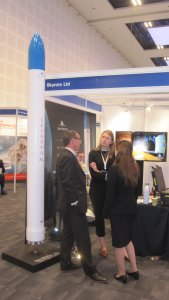
Would-be launch provider Skyrora was much in evidence at the UK Space Conference. Courtesy: Seradata/David Todd
The venue itself was good. Lecture rooms were close to each other avoiding long travel times. The food supplied was good and free (yippee!) – and was wisely put in the main exhibition. Washrooms were clean but with two failings – no hooks for jackets on the toilet doors and the toilet paper dispensers sometimes locked up with no way in to quickly fix them!
A plan to use the online Slido audience reaction system to get participants to post questions to panels was scuppered by a totally inadequate Wifi system at the event. The centre was well served by nearby hotels with a good round robin bus service.
The large exhibition hall was full, with smaller companies sent to the top floor. There was a lack of the really large exhibits that one tends to get at international events. Probably the most impressive show piece was on the main reception/registration floor – a giant inflated Moon.
Glam at the gala dinner…but don’t mention it…or Brexit
The Conference Gala dinner was quite pricey, but the Welsh lamb was good, as was the Welsh male voice choir laid on for entertainment. With nearly 600 guests such an event provides an opportunity to meet those who you might never otherwise connect with. But it did lack a proper UK space industry prize giving, having lost the Sir Arthur Clarke awards to the Rispace conference – not an ideal were their replacements: some made-up prizes related to the conference itself.
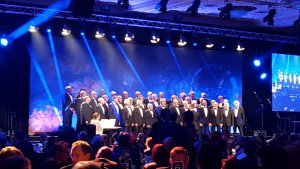
A Welsh male voice choir entertained at the UK Space Conference 2019 Gala Dinner event. Courtesy: Seradata/Tim Fuller
At least the event gave guests a chance to “glam up” from their usual work attire. While business suits were still on display, black tie was encouraged and about a third of the men took the chance to give their dinner jacket/tuxedo a run out. Mind you, your correspondent soon realised that he was no 007 as he struggled to fit his dinner jacket around his corpulent torso (no room for a Walther PPK or its shoulder holster in that get up!).
The women wore some very glamorous gowns, although the minefield of modern day sensibilities meant that it was safer to give small talk compliments to the beauty of the local Welsh scenery. Likewise, given the fractious UK political situation, many found that it was wiser to talk about the weather (it mainly rained that week) rather than Brexit politics.
Conclusion
Overall it was a very successful conference, albeit with a lack of major announcements. Perhaps that will happen next time. One final thing: it would be wise to do a deal with the British Interplanetary Society to alternate their Rispace conference which, to some extent, competes with this event. As it is, the UK Space Conference needs more technical content itself. Just talking about space policy and how to export more can get a bit wearing.


